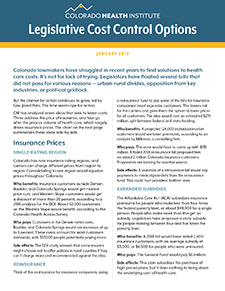Insurance Prices
Single Rating Region
Colorado has nine insurance rating regions, and carriers can charge different prices from region to region. Western Slope lawmakers want to consolidate to one region, so prices for the same policy could not vary throughout Colorado. Polis has voiced support for the idea.
Who benefits: Insurance customers outside Denver, Boulder, and Colorado Springs would get modest price cuts, and Western Slope customers would get a discount of more than 20 percent, according to a 2016 analysis for the DOI. About 52,000 customers on the Western Slope would benefit, according to the Colorado Health Access Survey.
Who pays: Customers in the Denver metro area, Boulder, and Colorado Springs would see increases of up to 9 percent. These areas account for most customers statewide, with 307,000 people potentially paying more.
Side effects: The DOI study warned that some insurers might choose not to offer policies in rural counties if they can’t charge more and recommended against the idea.
Bills: None introduced as of January 23.
Reinsurance
Think of this as insurance for insurance companies, using a reinsurance fund to pay some of the bills for insurance companies’ most expensive customers. This lowers risk for the carriers and gives them the option to lower prices for all customers. The idea would cost an estimated $270 million, split between federal and state funding.
Who benefits: A projected 124,000 individual market customers would see lower premiums, according to an analysis by Milliman, a consulting firm.
Who pays: The state would have to come up with $135 million. A failed 2018 reinsurance bill proposed fees on about 2 million Colorado insurance customers. Proponents are looking for another source.
Side effects: A variation of a reinsurance bill would cap payments to medical providers from the reinsurance fund. This could hurt providers’ bottom lines.
Bills: None introduced as of January 23, but one is expected.
Expanded Subsidies
The Affordable Care Act (ACA) subsidizes insurance premiums for people who make less than four times the federal poverty level, or about $49,000 for a single person. People who make more than this get no subsidy, and they have suffered the most from skyrocketing prices on the individual market. Legislators have proposed a state subsidy for people making between four and five times the poverty level.
Who benefits: A 2018 bill would have aided 2,400 insurance customers, with an average subsidy of $3,000, or $4,500 for people who were uninsured.
Who pays: The General Fund would pay $6 million.
Side effects: This plan subsidizes the purchase of high-priced plans, but it does nothing to bring down the underlying cost of health care.
Bills: None introduced as of January 23.
Health Care Prices
Hospital Financial Transparency
Legislators have tried to require hospitals to report financial and price data directly to the state. They have succeeded in getting hospitals to post some of their prices for people who pay cash (without insurance), but this is a small part of overall hospital charges.
Who benefits: Consumers and payers would be able to better understand hospital prices.
Who pays: Hospitals would face added regulatory costs and administrative burden.
Side effects: Studies show that consumers can’t — or won’t — shop around for most health care services.
Bills: House Bill 1001.
Hospital Facilities
Hospitals are taking heat for expanding facilities, especially in wealthier neighborhoods, while their revenues are up after the ACA and the cost shift to private payers continues to grow. Lawmakers have tried to adopt a certificate of need law to require state permission to build freestanding emergency rooms. Many states have this type of law, but Colorado does not.
Who benefits: Payers and consumers might benefit from halting the expansion of high-priced freestanding emergency rooms.
Who pays: Freestanding emergency room owners.
Side effects: The evidence is scant that certificate of need laws lower costs. Also, Colorado already has 50 freestanding emergency rooms that would not be subject to a certificate of need requirement.
Bills: House Bill 1010.
Medicaid Work Requirements
Under a federal waiver, legislators could require Medicaid members to show that they are working or have a valid reason not to, such as being disabled, attending school, or caring for a family member. If people didn’t comply, they would lose their coverage.
Who benefits: The state General Fund would save a projected $11 million, and the federal government would save around $130 million.
Who pays: An estimated 65,000 Coloradans would lose their Medicaid coverage.
Side effects: People who become uninsured would still have health costs that would be passed on to hospitals, government, and consumers.
Bills: None introduced as of January 23.
Medicaid Public Option
This idea has many variations. It would allow people who make too much to qualify for Medicaid to pay a monthly premium to join the government-run program. Legislators could decide to limit the option geographically or by income, or they could open it to anyone in the state.
Who benefits: Individual market customers could see an average premium price cut of 28 percent if they used the public option, according to an analysis commissioned by advocates of this plan.
Who pays: Providers would be paid less than they receive from private insurance.
Side effects: The public option could strain Medicaid’s provider network. Private insurers might object or even leave the market if the public option took away too much of their customer base.
Bills: House Bill 1004.




